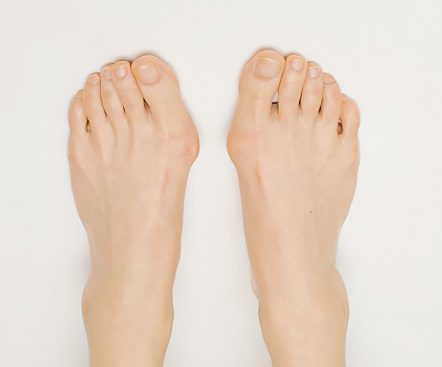
Orthopedic Surgery
Hallux valgus
‘Hallux ’ means the big toe. When the big toe is bent outward, it is called hallux valgus. If the big toe is severely bent toward the second toe, the second toe sometimes overlaps the big toe or the joint can be dislocated. Pain occurs when the inside of the big toe is bulged and its joint is irritated by a tight shoe as the tissue thickens and becomes inflamed.

Treatment of hallux valgus
-
Conservative treatment
It is recommended to wear comfortable shoes with enough width and low heels that do not irritate the bulged big toe. Orthodontic insoles can be placed inside the shoe. Braces can relieve symptoms, but they do not help correct the deformity.
-
Valgus hallux correction surgery
The surgical method can be decided depending on the degree of deformation. There are various methods of osteotomy to cut out the bone in the protruding area and correct the deformed joint angle. Because it also reconstructs soft tissue, it can not only correct foot deformity but also restore function.
Plantar fasciitis
The plantar fascia is a thick, strong fibrous band that is spread over the entire sole of the foot. It plays a role in maintaining the arch of the foot and absorbing shocks against the sole of the foot. If it is used excessively, the plantar fascia can have inflammation and you can feel severe oppressive pain in the heel of the medial foot. If the inflammation is left unattended for a long time, your daily activities can be restricted along with chronic heel pain.

Treatment of plantar fasciitis
-
As medication and stretching can take a long time for you to see improvement, extracorporeal shock wave therapy should be performed together.
-
Extracorporeal shock wave therapy (ESWT)
It is a simple but highly effective treatment that applies the principle of lowering sensitivity of the nerve to pain. A surgeon simply shoots a shock wave to the affected area.
Achilles tendinitis
As the Achilles tendon has no synovial membrane, it is weak against friction and can be easily damaged. Achilles tendonitis is an inflammation of the Achilles tendon, which is in the calf muscle that is attached to the heel. It occurs due to continuous and repeated stress. When you suddenly exercise excessively or intensively, the Achilles tendon can be damaged.

Treatment of Achilles Tendonitis
-
Mild symptoms can be relieved by medication and ice packs. You can lessen the pain by using an insole or orthosis that wraps the heel. Injection therapy and stretching can usually improve symptoms. Extracorporeal shock wave therapy (ESWT) applies the principle of lowering sensitivity of the nerve to pain. A surgeon simply shoots a shock wave to the area in pain and treats Achilles Tendonitis. If the damage is severe or completely ruptured, surgical reconstruction is required.
Ankle ligament injury
Ankle ligaments are likely to break and can be stretched when excessive force or an external shock is applied. When the ankle ligaments are damaged, the outside of the ankle becomes swollen with pain and bruises in severe cases. If a ligament is ruptured, it is difficult for you to walk or run properly and you can not exercise appropriately. Occasionally, bleeding may occur.

Treatment of ankle ligament injuries
-
When a ligament is ruptured, it doesn't cause any major problems right away, so most people are likely to delay treatment. However, if the ligament is not treated in time, it can cause chronic ligament instability, so appropriate timely treatment is required. It can be treated with manual therapy, sling exercise therapy, and extracorporeal shock wave therapy (ESWT). Surgery can also be performed to suture the lateral ligament in the injured ankle ligament. Reconstruction by implanting a structure can also be considered.
-
Arthroscopic surgery
An arthroscope with a camera is inserted into the ankle to clean up foreign substances and trim damaged cartilage in the joint. As a surgeon can see the surgical procedures in real time, accurate treatment is available. He/She can treat the damaged articular cartilage and the accompanying lesions as well.
*Rarely, there may be bleeding, infection, or blood clots during surgery.





